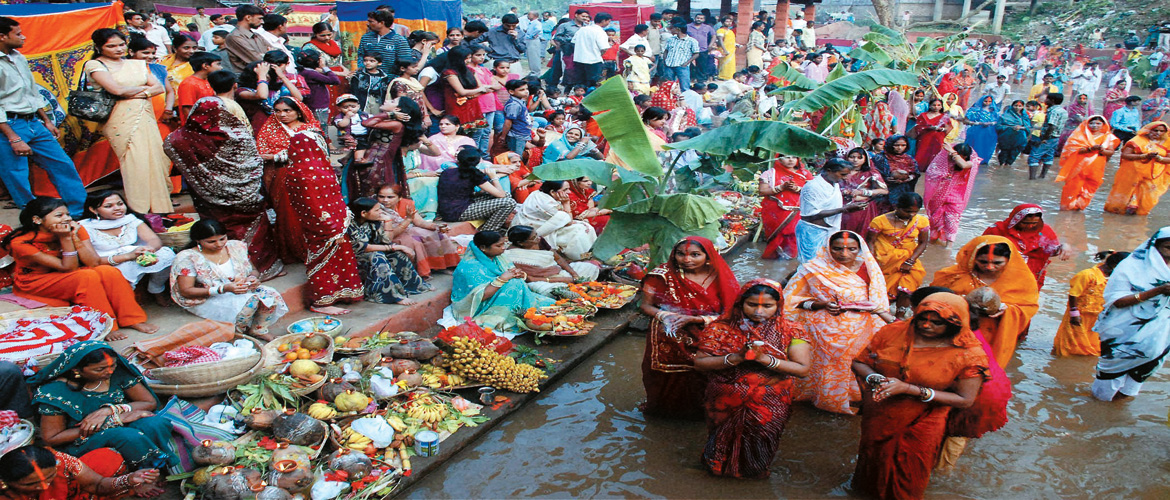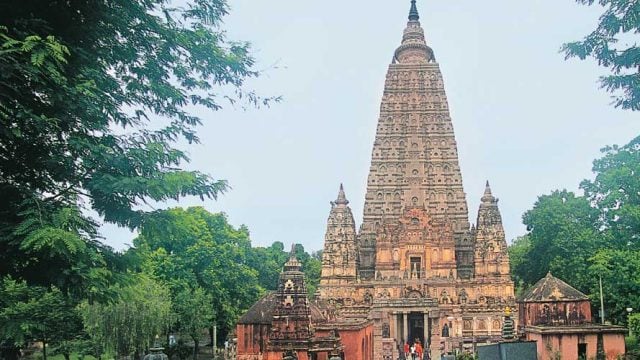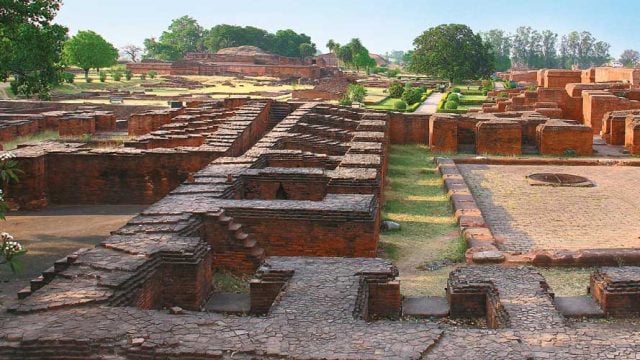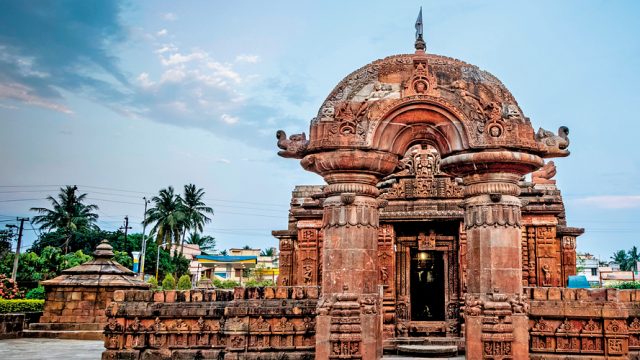Type Religious festival Time 4 days in November/ March–April Location Patna, Bihar In Patna, thousands
Chhath Puja or Surya Sashthi is celebrated twice a year – the first takes place a few days after Holi, on the sixth day of the Chaitra month (March–April) and is called Chaiti Chhath; while the second occurs six days after Diwali in the Kartik month (October–November) of the Hindu calendar. The latter is more popular since it takes place during an auspicious period.
The Legend
Considered to be one of the oldest forms of nature worship, Chhath Puja is mentioned in the Rig Veda as well as the Mahabharata. In the latter, Draupadi, the wife of the Pandava brothers, is advised by Sage Dhaumya to perform the puja in order to help the Pandavas regain their kingdom.
It is believed that the festival also honours Surya’s two wives – Usha and Pratyusha, with the former being referred to as Chhath Maiya (mother goddess). While Usha means ‘the first morning rays’, Pratyusha means the ‘last rays of the sun’. Prayers are, therefore, offered both at sunrise and sunset during the festival.

The Festival
The first day of the festival, known as Nahai Khai, sees devotees taking dips in the Ganga and offering prayers to the sun god. They then return from the ghat and clean their houses and surroundings to rid them of evil. Next, they prepare the food for the day, being mindful not to add onions or garlic to any dish. They use chulhas (earthen stoves powered by wood fire) for cooking. Those who don’t have a chulha at home use a stove and cylinder, stored specifically in their homes for this purpose. All meals for the day are prepared in ghee, and not in regular cooking oil. Rice, channa (chickpeas), kaddu (pumpkin) and dal are the main dishes prepared on this day.
Usually, one or two members in a family fast. They are called vratin (derived from the Hindi word vrat, which means fasting). The remaining members make arrangements for various rituals that are carried out over the course of the festival. The member who prepares the prasad, is also called vratin since he or she fasts as well.
The second day is called Kharna, when devotees observe an anhydrous fast from sunrise till sunset. The fast is broken after the evening prayers, by consuming the prasad, which consists of kheer (a sweet preparation of rice and milk) served with chapatis, and pua (sweet fried cakes made of wheat flour and bananas). Rice, dal and chutney are the main meals during the day.
On the third day, or the day of Chhath, vratins observe a day-long fast after taking a holy dip in the Ganga river and chanting hymns for the sun god. Later in the evening, they are accompanied to the ghat by the entire household and friends for the sandhya arghya (evening offering) of milk, water, colourful threads called baddhi and soop (semi-circular pans woven out of bamboo strips) containing fruits, sugarcane, shakkarkhand (fried pieces of dough coated in sugar) and paan (betel leaf filled with sweeteners and spices).
Female vratins break their fast with thekua (hard, wheat-based cake) and return home to perform Kosi – a ritual popular mainly in north Bihar. A mandap is set up, in the middle of which a miniature elephant toy is kept and colourful rangolis are made around it. Small sand saucers, with prasad in them, are placed around the mandap.
On the fourth day, devotees gather around the ghat and offer Usha arghya (morning offerings) to the rising sun. It is only after this puja that the worshippers break their fast. This marks the end of the rituals that are followed by the bursting of crackers, etc.
Although Chhath Puja is the biggest festival of Bihar, it is celebrated across the country and around the world amongst Bhojpuri and Maithili-speaking communities.
Other Places Of Interest
The best place to witness the festivities of Chhath is in Patna. This ancient city has several other attractions as well. With a history of over 3,000 years, Patna has a treasure trove of tourist sites.

Situated in the heart of the city is the Patna Museum, which was constructed in 1917. Influences of Mughal architecture are evident in the building. Golghar, near the Gandhi Maidan, is another attraction in the city. It was commissioned by Captain John Garstin in 1786 to be used as a granary. Agam Kuan (the unfathomable well) dates back to the period of Mauryan emperor Ashoka, who is said to have constructed it to torture people. It is said that Ashoka drowned his 99 brothers into the well to usurp the throne. Sanjay Gandhi Botanical Garden, Sri Krishna Science Centre and Indira Gandhi Planetarium are other attractions in Patna.
In its outskirts, Bodhgaya, Rajgir and Nalanda are must see locations, which can be covered in a day.
Shopping
Madhubani paintings made by the women of Mithilanchal are the most famous items to shop for when in Patna. At Khadi Gramudyog Bhavan, in Dak Bungalow Chauraha, you will find locally manufactured raw cotton kurtas and blouses. Maurya Lok and Hathwa Market are the two main shopping centres in the city.
Where to stay
The best option to stay in is the fittingly named Hotel Maurya-Patna (Tel: 0612-3051111, 2203040; Tariff: ₹14,000–34,000) in South Gandhi Maidan. They have a range of rooms and suites, restaurants, a bar and a gym.
Other high-end properties are Hotel Patliputra Exotica (Tel: 3301222; Tariff: ₹10,500–20,500); and Hotel Gargee Grand (Tel: 2500535–38; Tariff: Rs.8,000–18,500). Both hotels are on Exhibition Road, and have good restaurants and swimming pools. ITDC’s Patliputra Ashok (Tel: 2505270–76; Tariff: ₹5,000–11,000) also offers a swimming pool. Hotel Chanakya (Tel: 2223141–42, 2220590–96; Tariff: ₹7,000–20,000) on Bir Chand Patel Marg is also a good choice.
Decent mid-range accommodation options include Samrat International (Tel: 2220560–63; Tariff: ₹2,900–7,000) and President Hotel (Tel: 2209203–05, 3262880; Tariff: ₹1,700–3,000) on Frazer Road.All the hotels listed here have restaurants on site.
Where to Eat
Street food is pretty good in Patna. Litti Chokha, a staple dish of Bihar, can be found across the city, especially at streetside eateries. Maner Sweets in Maurya Lok has excellent Maneri laddoos. The jalebis at Pal Sweets, the khaja (a deep fried sweet dish made out of wheat flour and sugar) in the shops opposite Patna Museum, the paneer samosas and the kachoris at Lucknow Sweet House on Boring Road or at Maurya Lok, are some of the dishes you should try. Hotel Chanakya and Hotel Rajasthan have the two most popular restaurants in Patna.
FAST FACTS
Tourist offices
Directorate of Tourism
Government of Bihar
BSFC Building
Frazer Road, Patna
Tel: 0612-2332042
Bihar State Tourism Development Corporation
Bir Chand Patel Path
Patna, Bihar
Tel: 2225411, 2222622, 2210219
STD code 0612
GETTING THERE
Air Lok Nayak Jayaprakash Narayan International Airport is 8km away from the city. Prepaid taxis charge ₹360–1,200 depending on the vehicle
Rail Patna Junction is connected to Delhi, Kolkata, Mumbai, Ranchi, Guwahati and many other cities by superfast and express trains
Road NH19, 30, 83 and 98 connect Patna to major cities. Private taxis are available to major towns Bus The capital is served by a fleet of AC, non-AC, Volvo, luxury and sleeper buses. BSTDC buses start from Bir Chand Patel Path and State Govt BSRTC buses from Gandhi Maidan Bus Stand
Chhath Puja
festivals of India
March Festivals





